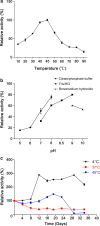Development of a whole-cell biocatalyst for diisobutyl phthalate degradation by functional display of a carboxylesterase on the surface of Escherichia coli
- PMID: 32471417
- PMCID: PMC7260753
- DOI: 10.1186/s12934-020-01373-6
Development of a whole-cell biocatalyst for diisobutyl phthalate degradation by functional display of a carboxylesterase on the surface of Escherichia coli
Abstract
Background: Phthalic acid esters (PAEs) are widely used as plasticizers or additives during the industrial manufacturing of plastic products. PAEs have been detected in both aquatic and terrestrial environments due to their overuse. Exposure of PAEs results in human health concerns and environmental pollution. Diisobutyl phthalate is one of the main plasticizers in PAEs. Cell surface display of recombinant proteins has become a powerful tool for biotechnology applications. In this current study, a carboxylesterase was displayed on the surface of Escherichia coli cells, for use as whole-cell biocatalyst in diisobutyl phthalate biodegradation.
Results: A carboxylesterase-encoding gene (carEW) identified from Bacillus sp. K91, was fused to the N-terminal of ice nucleation protein (inpn) anchor from Pseudomonas syringae and gfp gene, and the fused protein was then cloned into pET-28a(+) vector and was expressed in Escherichia coli BL21(DE3) cells. The surface localization of INPN-CarEW/or INPN-CarEW-GFP fusion protein was confirmed by SDS-PAGE, western blot, proteinase accessibility assay, and green fluorescence measurement. The catalytic activity of the constructed E. coli surface-displayed cells was determined. The cell-surface-displayed CarEW displayed optimal temperature of 45 °C and optimal pH of 9.0, using p-NPC2 as substrate. In addition, the whole cell biocatalyst retained ~ 100% and ~ 200% of its original activity per OD600 over a period of 23 days at 45 °C and one month at 4 °C, exhibiting the better stability than free CarEW. Furthermore, approximately 1.5 mg/ml of DiBP was degraded by 10 U of surface-displayed CarEW cells in 120 min.
Conclusions: This work provides a promising strategy of cost-efficient biodegradation of diisobutyl phthalate for environmental bioremediation by displaying CarEW on the surface of E. coli cells. This approach might also provide a reference in treatment of other different kinds of environmental pollutants by displaying the enzyme of interest on the cell surface of a harmless microorganism.
Keywords: Carboxylesterase; Cell surface display; Diisobutyl phthalate; Phthalic acid esters; Whole-cell biocatalyst.
Conflict of interest statement
The authors declare that they have no competing interests.
Figures






References
MeSH terms
Substances
Grants and funding
LinkOut - more resources
Full Text Sources
Molecular Biology Databases

